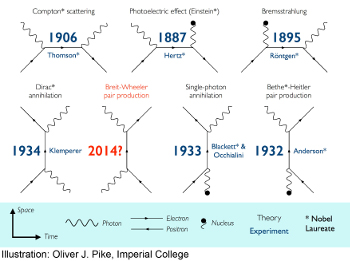
The confirmation of Breit-Wheeler pair production may occur forthwith after an 80-year wait.
A high-energy physics experiment proposed by physicists at Imperial College, London, may create matter from photons for the first time, confirming one of the most striking predictions of high-energy quantum physics. Since 1934, the Breit-Wheeler theory has predicted that it’s possible to create an electron-positron pair from a collision of two photons (ϒϒ’ → e+e-), but scientists have never observed it directly. Professor of physics Steve Rose and colleagues have come up with a way to demonstrate and observe this theory in practice (Nat. Photonics, doi:10.1038/nphoton.2014.95).
Researchers have in the past used laser beams, intense laser-plasma interactions and laser-based scattering of solid targets to produce experimental signatures of relativistic positrons from collisions with massive particles. The Breit-Wheeler theory is a simple mechanism using light rather than particles with mass, but its confirmation has been elusive, hampered by the requirement for high energies, high photon densities, and sensitive-enough detectors.
To confirm the theory, the research team has proposed the design of a new type of photon-photon collider in a special laser-heated vacuum called a hohlraum (German for hollow area). In the collider, a beam of ultra-relativistic electrons accelerated using high-intensity lasers passes through a solid gold target to produce gamma ray photons, which are then fired into the vacuum hohlraum. The photons interact with a high-temperature blackbody radiation field to produce electron-positron pairs that can be separated via a magnetic field. Monte Carlo simulations predict that 105 Breit-Wheeler pairs could be produced from a single shot of a 2 GeV electron beam into a 400 eV hohlraum. The pairs could be detected via Čerenkov radiation.
“The Breit-Wheeler process is in my opinion the most dramatic prediction of quantum electrodynamics that has yet to be observed,” said Rose. “This will be the first time that this fundamental process will have been seen.”
The set-up may also lend itself to studies of elastic photon-photon scattering and quark resonances.
